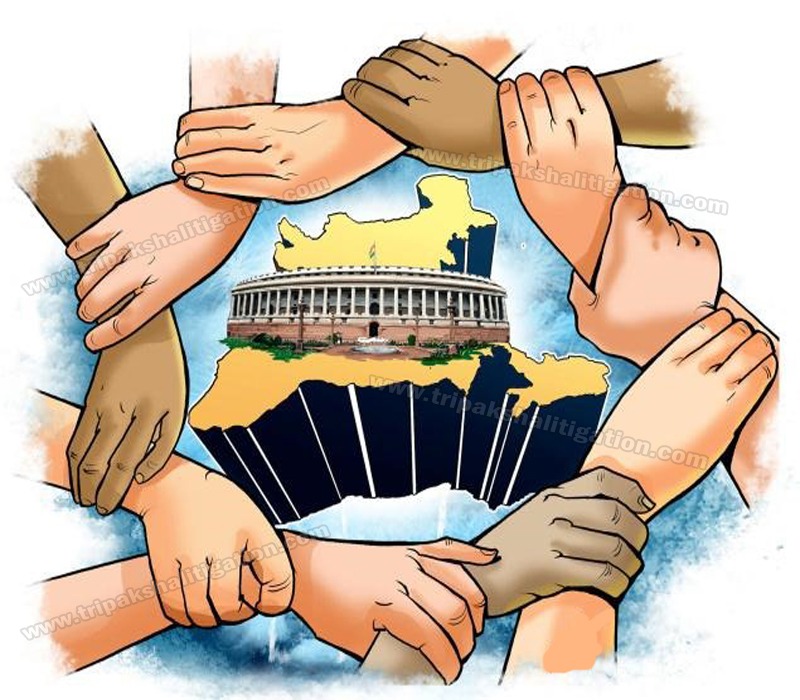Federalism in India is symmetrical in that the devolved powers of the constituent units are envisioned to be the same; it refers to relations between the Centre and states of Union of India.
DEFINITION:
The Indian constitution establishes a strong centre; accordingly as per “Paylee” it is “Perfectly Federal”.
Before going in the merit of the structure of the Indian constitution it becomes necessary to understand the meaning of the term “Federal Law”, least not to conflate the same with the much provided “State laws” to create balance in governing and meeting the justice as the very end.
In a more general sense, federal is ordinarily used to refer to a league or compact between two or more states to become joined under one central government.
Some laws are made at the federal level and some laws are made by the states. For example, laws on commerce, bankruptcy or taxation are made at the federal level.
Federal law, (Legal Definition), A body of law at the highest or national level of a federal government, consisting of a constitution, enacted laws and the court decisions pertaining to them.
Merriam Webster (Dictionary) defines federal law as embodied in the rules, regulations, and decisions of public federal administrative agencies entrusted with the enforcement of various federal statutes as distinguished from the decisions of the federal courts interpreting and applying these statutes in individual cases.
INTRODUCTION:
India became an independent democratic republic in 1947 and its constitution, which came into force on 26th November 1949, is the supreme law.
The constitution is based on the Government of India Act 1935 passed by British Parliament. The Indian constitution lays out a federal Union of 28 States, 6 union territories and 1 national capital territory. The Union and States have separate executive and legislative branches, whereas the territories are ruled by the national government. Law generated by the Union is superior to that of the States.
India has a bicameral Parliament whose upper house is the Council of States (Rajya Sabha) and whose lower house is the House of People (Lok Sabha). The State executive is headed by a Governor, and while most have a unicameral legislative body called the Legislative Assembly.
The constitution prescribes a federal structure of government, with a clearly defined separation of legislative and executive powers between the Federation and the States.Each State Government has the freedom to draft its own laws on subjects classified as state subjects. Laws passed by the Parliament of India and other pre-existing central laws on subjects classified as central subjects are binding on all citizens. However, the Constitution also has certain unitary features, such as vesting power of amendment solely in the Federal Government, the absence of dual citizenship, and the overriding authority assumed by the Federal Government in times of emergency.
FEDERALISM IN INDIA:
Federalism in India refers to relations between the Centre and states of Union of India. The Constitution of India establishes structure of the Indian government. Part XI of the Indian constitution specifies the distribution of legislative, administrative and executive powers between the union government and the States of India. The legislative powers are categorized under a Union List, a State List and a Concurrent List, representing, respectively, the powers conferred upon the Union government, those conferred upon the State governments and powers shared among them.
This federalism is symmetrical in that the devolved powers of the constituent units are envisioned to be the same. Historically, the state of Jammu and Kashmir was accorded a status different than other States owing to a explicitly temporary provision of the Indian Constitution namely Article 370 (which was revoked by the union government in 2019).
Union territories are unitary type, directly governed by the Union government. Article 1 (1) of the constitution stipulates two tier-governance with an additional local elected government. Delhi and Pondicherry were accorded legislatures under Article 239AA and 239A, respectively.
The Indian federalism was not a result of a compact between several sovereign, units but a result of conversion of a unitary system into a federal system. Here, the movement has been from unity to union, from unitarism to federalism. In India, it was rather the reverse process, namely, to convert a unitary constitution into a federal constitution. The fundamental principle of federalism is that the legislative and executive authority are partitioned between The center and states not by mean of an ordinary law passed by the center, but by something more enduring, namely, the constitution. The states do not depend on the center, for in normal times, the center cannot intrude in their domain. It may be that the center has been assigned a larger role that the states, but that by itself does not detract from the ‘federal Nature’ of the constitution, for it is not the essence of federalism to say that only so much and no more, power is to be given to the center.
In West Bengal vs. UOI, the Supreme Court took note of this process and rejected the claim of the states that they shared sovereignty with the center. Second, the past history of India conclusively establishes that in the absence of a strong central government, the country soon disintegrates. This belief was strengthened by the recent partition of the country. Therefore, adequate precautions have to be taken against any such future contingency by making the center strong. Owing To its vastness of territory and variety of people, India could not be governed efficiently as a unitary state and so a unitary constitution was out of the question.
THE ASYMMETRIC FEDERALISM:
The main forms of administrative units in India are the Centre and the States. But there are other forms, too, all set up to address specific local, historical and geographical contexts. Besides the Centre and the States, the country has Union Territories with a legislature and Union Territories without a legislature.
When the Constitution came into force, the various States and other administrative units were divided into Parts A, B, C and D. Part ‘A’ States were the erstwhile provinces, while Part B consisted of erstwhile princely states and principalities. Part C areas were the erstwhile ‘Chief Commissioner’s Provinces’. They became Union Territories, and some of them initially got legislatures and were later upgraded into States. Himachal Pradesh, Manipur, Tripura, Mizoram, Arunachal Pradesh and Goa belong to this category.
Just as the Centre and the States do not have matching powers in all matters, there are some differences in the way some States and other constituent units of the Indian Union relate to the Centre. This creates a notable asymmetry in the way Indian federalism works.
INDIAN JUDICIARY:
In India, the constitution is governed by the rule of law, and judicial review of administrative action is an essential part of rule of law. Thus, courts can determine not only the constitutionality of the law but also the procedural part of administrative action. However, since it is a written constitution and the powers and functions of every organ are defined and delimited by the constitution, there is no question of any organ, not even parliament being sovereign. Both parliament and the Supreme Court are supreme in their respective spheres.
While the Supreme Court may declare a law passed by parliament ultra virus as being volatile of the constitution, parliament may within certain restriction amend most parts of the constitution. This judicial supremacy makes India a truly federal state which is the heart of Indian federal structure. It is because of independent of judiciary that “basic structure of constitution” theory has been adopted which somehow limits the powers of parliament from being amended the basic fundamental structure of constitution.
The judiciary is independent rather than federal in structure. The highest appellate court of the judiciary is the Supreme Court of India, which often decides the legislative powers demarcated by the Constitution for Union and States. Prior to independence in 1947, the highest appellate court was the Privy Council in London and its decisions can still be binding unless overruled by the Supreme Court. High Courts are situated in each State, with subordinate criminal and civil courts.
Article 131 confers exclusive jurisdiction on the Supreme Court in disputes involving States, or the Centre on the one hand and one or more States on the other. This means no other court can entertain such a dispute. It is well-known that both High Courts and the Supreme Court have the power to adjudicate cases against the State and Central governments. In particular, the validity of any executive or legislative action is normally challenged by way of writ petitions under Article 226 of the Constitution in respect of High Courts, and, in respect to fundamental rights violations, under Article 32 in the Supreme Court.
CONCLUSION:
The federal structure of 1935 influenced the India’s choice of constitution after freedom and led to the adoption of a “cooperative federation”. The policy of linking democratization to federalism encouraged dissention and confrontation by inspiring forces of regionalism and complicated the entire question of constitutional reforms by compounding it with the problems of princely states. In attending to accommodate the concept of responsible government in ten provinces within the specifications of their federal design wherein the center was to remain in real control and authority over the provinces. This federal pattern draws out a fine distinction between the expressions “UOI” and “Territory of India.” The former includes only the states which enjoy the status of being members of the federal system and share a distinction of powers with the union. The latter includes the entire territory over which the sovereignty of India for the time being extends and “territory of India” comprises the territories of states, union territories and other territories which can be acquired from time to time.
It would not be out of place to try to understand the two different yet related concepts of federation and confederation as:
A federation is an intimate legal association between two units the center and the states. Center is only one, but the states may be any number, either two or more. A confederation is a loose association of two or more sovereign states usually born of a treaty.
A federation is usually indissoluble and the states have no right to secede. This is the case in the U.S.A., India, Canada, and Australia. The confederation being a loose combination allows the states to secede, for example, common wealth of independent states called ‘CIS’ of erstwhile Union of Soviet Socialist Republics.
The federation is a sovereign body and is an international person i.e., a person recognized by international law. A confederation is not an international person. It is not a sovereign body. The constituent states are sovereign and may enjoy independent status in international law.
In a federation, there is a legal relationship between the individual and the federation called citizenship. In a confederation, the people are citizens of a state and not that of the confederation.
Article 1 (3) (c) does not expressly confer power on the government of India to acquire new territories, but it is the inherent the right of a sovereign state to acquire a foreign territory, and no parliamentary legislation is required for this purpose. It is to be noted that only “States” are the members of the UOI (by virtue of Article 1). In state of Haryana vs. state of Punjab, “semi federal” was used and in “Shamsher Singh vs. state of Punjab”, the constitution was called “more unitary than federal”. In India, the union is indissoluble but not so the state. No state can secede The Supreme Court has described the Indian polity as an indestructible union composed of destructible states. It means that the union cannot be destroyed by succession. No state possesses the right to separate itself from the federation.
You may contact me for consultation or advice by visiting Contact Us








